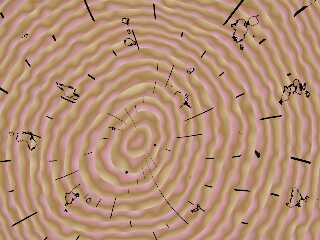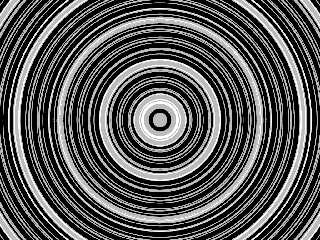 |
 |
|
 |
|
 |
|  |
|  |
|
 |
|
 |
|  |
|  |
|
 |
I have to tell you, this is a tough problem, to make a fully procedural wood
texture.
I think a lot of things have to be "fixed" in order to get good results - like
color-map cycling, the behaviour of the modulo operator across the origin, and
the domain of user generated functions.
I got a very rough simulation, but it's a layered texture, to get the checking
(cracks) and spalting.
To get a better wood, there would have to be knots and burls in 3D so that it
could also be used as an isosurface.
- BW
Post a reply to this message
Attachments:
Download 'radialfunctions.png' (322 KB)
Preview of image 'radialfunctions.png'

|
 |
|  |
|  |
|
 |
|
 |
|  |
|  |
|
 |
"Bald Eagle" <cre### [at] netscape net> wrote:
> I have to tell you, this is a tough problem, to make a fully procedural wood
> texture.
>
No no...
Make a fully procedural wood texture is interesting to me. It is keep my
attention these days.
> I think a lot of things have to be "fixed" in order to get good results - like
> color-map cycling, the behaviour of the modulo operator across the origin, and
> the domain of user generated functions.
>
I solved color-map cycling by creating main part of pigment (using function) ,
such function change its value from 0~1~0 every year. It has been done, so I
don't concern it anymore.
"The domain of user generated function" means I needs provide something flexible
for user to apply their own function. Before that time I can offer the standard
function which I developed.
> I got a very rough simulation, but it's a layered texture, to get the checking
> (cracks) and spalting.
>
How do you get such black spalting?
> To get a better wood, there would have to be knots and burls in 3D so that it
> could also be used as an isosurface.
>
> - BW
I will add knots in my output pigment pattern when I prepare enough code. But
they are just pattern, not a 3D shape. net> wrote:
> I have to tell you, this is a tough problem, to make a fully procedural wood
> texture.
>
No no...
Make a fully procedural wood texture is interesting to me. It is keep my
attention these days.
> I think a lot of things have to be "fixed" in order to get good results - like
> color-map cycling, the behaviour of the modulo operator across the origin, and
> the domain of user generated functions.
>
I solved color-map cycling by creating main part of pigment (using function) ,
such function change its value from 0~1~0 every year. It has been done, so I
don't concern it anymore.
"The domain of user generated function" means I needs provide something flexible
for user to apply their own function. Before that time I can offer the standard
function which I developed.
> I got a very rough simulation, but it's a layered texture, to get the checking
> (cracks) and spalting.
>
How do you get such black spalting?
> To get a better wood, there would have to be knots and burls in 3D so that it
> could also be used as an isosurface.
>
> - BW
I will add knots in my output pigment pattern when I prepare enough code. But
they are just pattern, not a 3D shape.
Post a reply to this message
|
 |
|  |
|  |
|
 |
|
 |
|  |
|  |
|
 |
"And" <49341109@ntnu.edu.tw> wrote:
> How do you get such black spalting?
#declare Crack1 =
color_map {
[0.00 rgb 1]
[0.50 rgb 1]
[0.50 rgb 0]
[0.55 rgb 0]
[0.51 rgb 1]
[1.00 rgb 1]
}
#declare Spalting = function {pigment {leopard turbulence 1 color_map {Crack1}}}
Post a reply to this message
|
 |
|  |
|  |
|
 |
|
 |
|  |
|  |
|
 |
I think I should learn Javafx first to rewrite it. My knowledge of design
program is not enough.
Post a reply to this message
|
 |
|  |
|  |
|
 |
|
 |
|  |
|  |
|
 |
"And" <49341109@ntnu.edu.tw> wrote:
> I think I should learn Javafx first to rewrite it. My knowledge of design
> program is not enough.
Here's a dispersion pattern I found that seems to also make a good wood ring
pattern.
https://en.wikipedia.org/wiki/Dispersion_(water_waves)#Dispersion_relation
https://www.desmos.com/calculator/dzrqmexxik
#declare T_wave = 0.5; // -10 to 10 in example
#declare FWave1 = function {sum (k_wave, 0.3, 3, mod ( (sqrt(x*x+y*y) - sqrt
(9.81*k_wave*3)*T_wave)*k_wave*3, 2*pi) <= 1)}
#declare FWave2 = function {sum (k_wave, 0.3, 3, abs ( (sqrt(x*x+y*y) - sqrt
(9.81*k_wave*3)*T_wave)*k_wave*3) <= 0.3)}
#declare Formula201 = function {(FWave1 (x, y, z) + FWave2 (x, y, z))/2}
plane {z, 0 pigment {function {Formula201 (x,y,z)} } }
Add 2 different color maps for light and dark wood, and it should look a lot
better.
Post a reply to this message
Attachments:
Download 'mathpatterns1.png' (334 KB)
Preview of image 'mathpatterns1.png'

|
 |
|  |
|  |
|
 |
|
 |
|  |
|  |
|
 |
"Bald Eagle" <cre### [at] netscape net> wrote:
> Here's a dispersion pattern I found that seems to also make a good wood ring
> pattern.
>
> https://en.wikipedia.org/wiki/Dispersion_(water_waves)#Dispersion_relation
> https://www.desmos.com/calculator/dzrqmexxik
>
> #declare T_wave = 0.5; // -10 to 10 in example
> #declare FWave1 = function {sum (k_wave, 0.3, 3, mod ( (sqrt(x*x+y*y) - sqrt
> (9.81*k_wave*3)*T_wave)*k_wave*3, 2*pi) <= 1)}
> #declare FWave2 = function {sum (k_wave, 0.3, 3, abs ( (sqrt(x*x+y*y) - sqrt
> (9.81*k_wave*3)*T_wave)*k_wave*3) <= 0.3)}
> #declare Formula201 = function {(FWave1 (x, y, z) + FWave2 (x, y, z))/2}
>
> plane {z, 0 pigment {function {Formula201 (x,y,z)} } }
>
> Add 2 different color maps for light and dark wood, and it should look a lot
> better.
I see this idea describing...
"when annual ring pattern is not very clear" net> wrote:
> Here's a dispersion pattern I found that seems to also make a good wood ring
> pattern.
>
> https://en.wikipedia.org/wiki/Dispersion_(water_waves)#Dispersion_relation
> https://www.desmos.com/calculator/dzrqmexxik
>
> #declare T_wave = 0.5; // -10 to 10 in example
> #declare FWave1 = function {sum (k_wave, 0.3, 3, mod ( (sqrt(x*x+y*y) - sqrt
> (9.81*k_wave*3)*T_wave)*k_wave*3, 2*pi) <= 1)}
> #declare FWave2 = function {sum (k_wave, 0.3, 3, abs ( (sqrt(x*x+y*y) - sqrt
> (9.81*k_wave*3)*T_wave)*k_wave*3) <= 0.3)}
> #declare Formula201 = function {(FWave1 (x, y, z) + FWave2 (x, y, z))/2}
>
> plane {z, 0 pigment {function {Formula201 (x,y,z)} } }
>
> Add 2 different color maps for light and dark wood, and it should look a lot
> better.
I see this idea describing...
"when annual ring pattern is not very clear"
Post a reply to this message
|
 |
|  |
|  |
|
 |
|
 |
|  |
|  |
|
 |
"And" <49341109@ntnu.edu.tw> wrote:
> I see this idea describing...
> "when annual ring pattern is not very clear"
I just posted it to show that there are a lot of functions out there, and we can
mix and match them to eventually get the final result that we're looking for.
Whereas some base patterns may be well suited to modification and perturbation
in certain ways, others may not be.
So I think that at the present, in the absence of anything concrete, it's good
to compile a list of options, and then see what the strengths and weaknesses of
them are, and proceed from there.
And at some future point, someone may find it useful for some thing that's - not
wood.
- BE
Post a reply to this message
|
 |
|  |
|  |
|
 |
|
 |
|  |
|  |
|
 |
"Bald Eagle" <cre### [at] netscape net> wrote:
> "And" <49341109@ntnu.edu.tw> wrote:
>
> > I see this idea describing...
> > "when annual ring pattern is not very clear"
>
> I just posted it to show that there are a lot of functions out there, and we can
> mix and match them to eventually get the final result that we're looking for.
>
> Whereas some base patterns may be well suited to modification and perturbation
> in certain ways, others may not be.
>
> So I think that at the present, in the absence of anything concrete, it's good
> to compile a list of options, and then see what the strengths and weaknesses of
> them are, and proceed from there.
>
> And at some future point, someone may find it useful for some thing that's - not
> wood.
>
> - BE
Well. net> wrote:
> "And" <49341109@ntnu.edu.tw> wrote:
>
> > I see this idea describing...
> > "when annual ring pattern is not very clear"
>
> I just posted it to show that there are a lot of functions out there, and we can
> mix and match them to eventually get the final result that we're looking for.
>
> Whereas some base patterns may be well suited to modification and perturbation
> in certain ways, others may not be.
>
> So I think that at the present, in the absence of anything concrete, it's good
> to compile a list of options, and then see what the strengths and weaknesses of
> them are, and proceed from there.
>
> And at some future point, someone may find it useful for some thing that's - not
> wood.
>
> - BE
Well.
Post a reply to this message
|
 |
|  |
|  |
|
 |
|
 |
|  |
|
 |




![]()